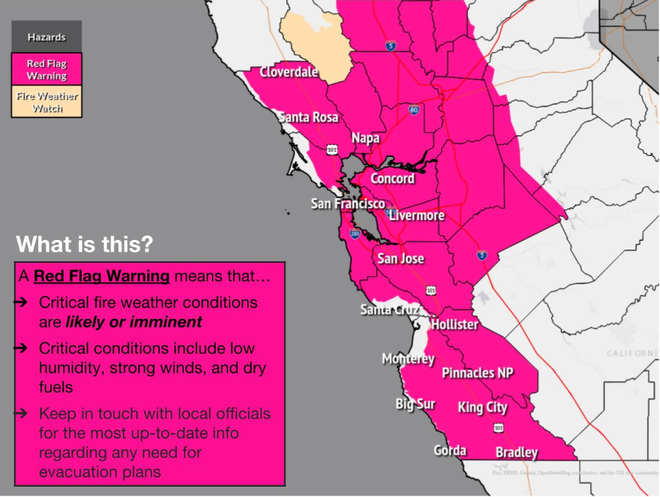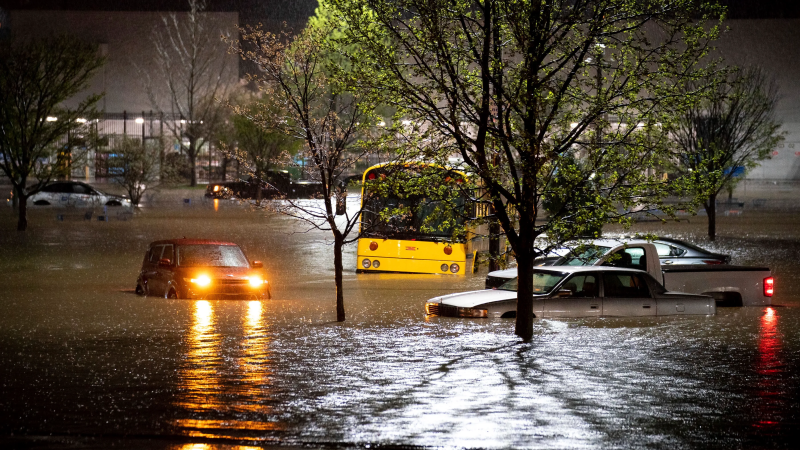'Diablo wind' in California could spark fires, lead to power shutdown for 30,000
SAN FRANCISCO − A "devil wind" is coming to northern and coastal California, and it could mean pre-emptive power shutdowns for close to 30,000 households in 30 counties as soon as Thursday, the local power company warns.
To protect against accidentally setting fires, Pacific Gas & Electric sent notices to potentially affected customers across a wide swath of the state's north and central coastal area, saying it may need to shut down power to lines to affected areas to limit the possibility of electrical sparks.
The National Weather Service issued a "red flag warning" for northern California beginning Thursday night until Saturday night, meaning "critical fire weather conditions are likely or imminent." Officials warn potentially affected residents to have an emergency plan in case a fire starts near them.
"Diablo wind" is the local name for hot, dry winds from the northeast that sometimes hit the San Francisco Bay area and central coastal of California, especially in the spring and fall. The Southern California term for a similar phenomenon is the Santa Ana winds.
Studies have found that climate change is increasing the likelihood of autumn wind-driven extreme fire conditions.
"The winds are coming from the north, not the typical sea breeze from the water which would be cooler," said Roger Gass, a meteorologist with the San Francisco Bay Area office of the National Weather Service.
These conditions make the area ripe for easier fire starts and potential explosive fire spread.
Previous fires driven by Diablo winds have included the Oakland Hills Firestorm in 1991, which killed 25 people and began with a small fire on private property. The Tubbs Fire in 2017 in Napa County killed 22 people and burned 36,000 acres. It was caused by a private electrical system. The Kincade Fire in 2019 in Sonoma County began when a cable on a PG&E transmission tower broke.

Included in the potential at-risk area are cities such as Napa, Berkeley, San Jose and Big Sur.
Warm temperatures, extremely dry vegetation and strong winds of 25 to 35 mph, with some gusts as high was 65 mph, are a recipe for potential conflagration.
"This may be the highest fire risk period of the year so far," Daniel Swain, a climate scientist a the University of California, Los Angeles, said on X.

Northern and central California have had a long, hot and very dry summer, and some areas have had almost no rain at all since July 1, according to Golden Gate Weather Services.
"Fuels are critically dry," Gass said. "If we had had rain, we would not be concerned."
That means no campfires, fire pits or BBQs. Vehicles are also prohibited from driving off-road where they could ignite a grass fire. Residents are warned to avoid using mowers or other power tools outdoors and asked to double-check trailer chains to make sure they're not dragging on the road as the friction can create sparks.
As the California Department of Forestry and Fire Protection puts it, "One less spark, one less wildfire."
"That's how most fire start, they're human-made," Gass said. The National Parks Service puts the number of human-sparked blazes at 85%.
Disclaimer: The copyright of this article belongs to the original author. Reposting this article is solely for the purpose of information dissemination and does not constitute any investment advice. If there is any infringement, please contact us immediately. We will make corrections or deletions as necessary. Thank you.







